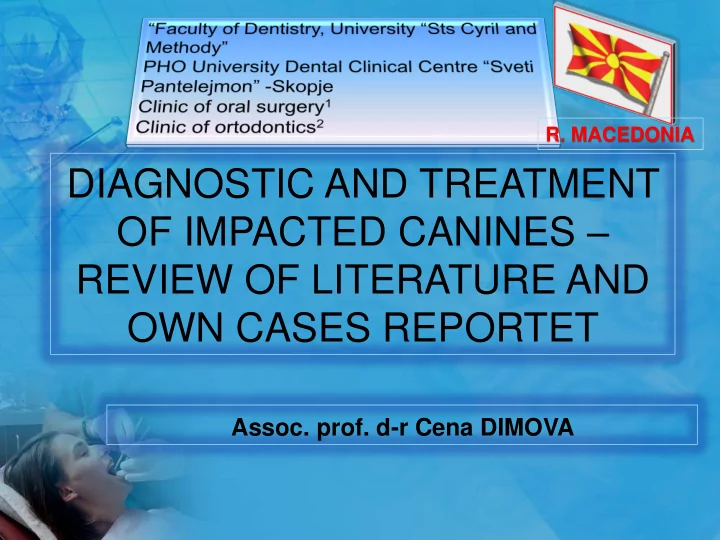

R. MACEDONIA DIAGNOSTIC AND TREATMENT OF IMPACTED CANINES – REVIEW OF LITERATURE AND OWN CASES REPORTET Assoc. prof. d-r Cena DIMOVA
INTRODUCTION - Prevalence and etiology UP DATE IN THE MANAGEMENT - Diagnosis • Visual inspection • Palpation • Radiographs - Interceptive treatment CASE REPORTS 2
E fficient office management and success in oral surgery and orthodontic practice together require an accurate prediction of treatment duration. P atients who complete treatment on time may be more satisfied and more likely to refer other patients for oral surgery and orthodontic treatment. A n accurate prediction of treatment duration and the number of office visits needed to treat a patient will facilitate control of office overhead and enable the orthodontist to better determine an acceptable fee ( Stewart et al. ). A ccording to Dewel “no tooth is more interesting from a development point of view” than the maxillary canine. Stewart et al. Factors that relate to treatment duration for patients with palatal impacted maxillary canines. American Journal of Orthodontics and Dento facial Orthopedics March 2001 (3), 119:216-25 Dewel BF. The upper cuspid: its development and impaction. Angle Orthod 1949;19:79-90.
Prevalence I mpacted teeth are those with a delayed eruption time or that are not expected to erupt completely based on clinical and radiographic assessment. P ermanent maxillary canines are the second most frequently impacted teeth; the prevalence of their impaction is 1-2% in the general population. T his is most likely due to an extended development period and the long, tortuous path of eruption before the canine emerges into full occlusion.
Palatal and vestibular canine impaction are considered to be completely different entities. Eighty-five per cent of impacted maxillary permanent cuspids are palatal impactions, and 15% are labial impactions. Vestibular canine impaction is thought to be a form of crowding. Insufficient space in the upper arch for the eruption of the maxillary canine culminates in its impaction (Jacoby 1983). Given time and space this tooth will usually erupt in the oral cavity. Al- Nimri & Gharaibeh . Space conditions and dental and occlusal features in patients with palatal impacted canines: an etiological study. European Journal of Orthodontics. 2005 (27): 461-5
• The etiology of palatal canine impaction is not very clear. The opinions are different. • Some literary data showed that, contrary of vestibular space impaction, that the presence of excess space in the upper dental arch could lead to palatal impaction by allowing the canine cross back from the vestibular to the palatal side. • Due to denser palatal bone and thicker palatal mucosa, as well as a more horizontal position, palatally displaced cuspids rarely erupt without requiring complex orthodontic treatment. Palatally erupting or impacted maxillary canines occur twice as often in females than males have a high family association. Bishara SE. Impacted maxillary canines: a review. Am J Orthod Dentofacial Orthop 2002; 101:159-71. 6
-The prevalence of maxillary canine impaction is significant and the frequency increases with other genetically associated dental anomalies. -The astute practitioner should be aware of dental anomalies that occur with palatally impacted maxillary canines so that early recognition and interceptive treatment is possible. - More important, if signs of ectopic eruption are detected early, every effort should be made to prevent impaction and its consequences.
- Current protocol involves judicial extraction of the primary cuspid and radiographic follow-up for 12 months to monitor eruption. -The need for complex orthodontic therapy and surgical intervention may be avoided if the deciduous canines are extracted appropriately. - Early intervention can spare the patient time, expense, more complex treatment and injury to otherwise healthy teeth.
- Completing the orthodontic part of the therapy does not mean finalization of the definitive treatment of the impacted canines. - An appropriate periodontal status of the repositioned impacted tooth as well as of the nearby teeth is the only reward for the dentists for a successful oral-surgical as well as orthodontic therapy of the impacted canines.
Recommend
More recommend